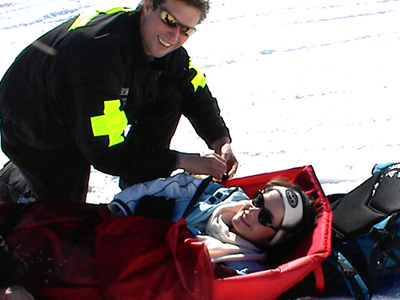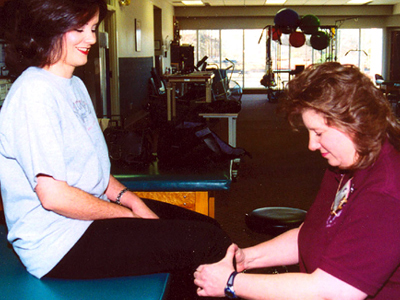JACKSON, Miss.—If you’re a Mississippian headed for the ski slopes this March, take care that you don’t come back with a “spring break.”
Injuries are common among Southerners who ski only once or twice a year, said Karan Redditt, a physical therapist and certified sports therapist for Methodist Rehabilitation Center in Jackson.
“It’s usually because of a lack of experience or exposure to the slopes,” Redditt said.
Lori Gillis is one whose tenderfoot status left her with a tender knee. Her introduction to skiing included a rescue by the ski patrol.
“The first time off the lift, I fell halfway down the mountain,” said Gillis, a research analyst for The Cirlot Agency in Flowood. “I tried to stop myself by sitting down and threw a ski. I twisted my knee and got a partial tear of my anterior cruciate ligament (ACL). I also tore the meniscus in my knee.”
Injuries like Gillis’ are as familiar as long lines at the ski lift, and many share a common theme, Redditt said. “Often the person falls, and their skis don’t come off, and they get twisted around,” she said. “Injuries also happen when skiers try to do a snowplow to stop and their quadriceps muscles aren’t strong enough. And some people just hurt themselves slipping on the ice.”
Redditt said another culprit is modern ski boots, which limit ankle mobility and direct more stress on the knee and upper leg. The result is knee injuries, bone fractures and damage to surrounding muscles, tendons and ligaments.
While knee and leg injuries probably send more skiers to the doctors, upper body injuries are a risk as well, Redditt said. “Skiers also can get tennis elbow from planting and pushing their ski poles while doing moguls. And some get tendinitis in the thumbs from the way they grip their ski poles.”
Redditt said one way to avoid such problems is to begin conditioning long before your first slide down the bunny slope.
“Two months prior to your trip you should start training three to four times a week,” Redditt said. She recommends a program that includes cardiovascular exercises for endurance, such as walking, running or biking, and strength-training exercises to condition your upper and lower extremities, such as leg extensions, curls and squats.
“If you don’t belong to a gym, you can use resistance tubing or buy ankle weights and lie on your side and do leg lifts or sit in a chair and do extensions,” Redditt said. Or you can try wall slides—putting your back against a wall and sliding down into a sitting position.
Given she had weak knees to begin with, Gillis admits she would have been wise to prepare for her time on the slopes. But her trip was truly a lark. “I was just on vacation and had a free day so I said: ‘Let’s do this. It will be fun.’”
That impulsiveness almost landed her in a surgical suite. But thanks to a month of therapy at Methodist Rehab’s outpatient clinic in Flowood, Gillis said she was able to avoid the knife. “I’ve gotten back my range of motion, and now I go to the gym four or five times a week,” she said. “I’m in much better shape.”
Gillis is even thinking she might try skiing again—only this time, she won’t be as impetuous. “I would get an instructor and let somebody professional teach me how to do it instead of playing with my friends.”
That’s good advice, said Redditt, who recommends that every rookie spend some time in ski school.
“Take at least one or two days of lessons. Make sure you learn how to get on and off the ski lift, how to keep your skis together, how to stop and how to fall correctly. You should also know how to properly adjust your ski bindings. They need to be loose enough to release in a fall, but not so loose that they fall off.”
Before you finally join the line for the ski lift, Redditt recommends that you take some time to stretch and do cardiovascular exercises as a warm-up. Then once you get on the slopes, pay attention to your body’s signals to avoid another great cause of injury—fatigue.
“When I start feeling short or breath, have difficulty controlling the skis or start experiencing lower extremity weakness, I know it’s a good time to rehydrate and take a rest,” Redditt said.
Got questions about getting in shape for skiing? Then click here to ask Sports Therapist Karan Redditt. Log on to www.methodistonline.org to read her answers to sports and fitness questions.
For more information:
Preparation key to enjoying ski slopes | The Clarion-Ledger


